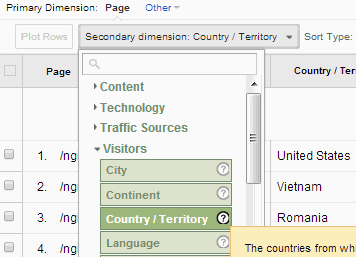Enhance Your Coverage with Secondary Dimension in Google Analytics
Enhance Your Coverage with Secondary Dimension in Google Analytics
Blog Article
Maximize Reporting Precision With Additional Measurement in Google Analytics
Comprehending how to make best use of reporting accuracy with additional measurements in Google Analytics can significantly enhance the deepness of insights stemmed from information evaluation. By integrating second measurements purposefully, marketing professionals can reveal covert patterns and correlations that may not be right away evident when evaluating main metrics alone. This nuanced method makes it possible for a much more thorough understanding of individual habits and campaign efficiency, leading the way for more targeted and efficient decision-making. The utilization of additional dimensions holds the key to opening a wide range of beneficial details that can transform the efficiency of electronic advertising strategies.
Recognizing Secondary Measurements in Google Analytics
To boost data evaluation and gain much deeper understandings right into individual behavior, recognizing secondary dimensions in Google Analytics is vital. Additional dimensions permit customers to segment and further explore information past the primary dimension chosen. By integrating second dimensions, experts can fine-tune their reports to reveal even more detailed info regarding customer communications on a site. As an example, while the key measurement may show the complete number of web page views, adding an additional dimension such as 'source/medium' can give understandings right into where the web traffic stemmed from. This additional layer of info makes it possible for marketing experts to analyze the efficiency of various marketing campaigns or networks in driving traffic to the web site.
Furthermore, understanding additional dimensions is important for developing a lot more tailored records tailored to specific business objectives. By picking the best mix of secondary and key measurements, experts can uncover patterns, fads, and relationships that might otherwise remain covert. This nuanced approach to data evaluation equips organizations to make informed decisions based on a detailed understanding of individual actions across various measurements.

Exactly How to Apply Additional Measurements
When leveraging secondary dimensions in Google Analytics, the useful application includes picking details information parameters to more improve insights past the key dimension's scope. To apply additional dimensions successfully, start by accessing the record or dataset where you want to dig much deeper into the information. Remember that additional dimensions aid offer context and granularity to your main measurement data, enabling you to draw out even more workable and meaningful insights from your Google Analytics reports.
Leveraging Additional Measurements for Insights
Making use of second dimensions in Google Analytics enables an extra extensive evaluation of information, offering important understandings beyond the key dimension's extent. By leveraging additional dimensions, customers can dive deeper into the efficiency metrics of their web site or app, discovering covert patterns and fads that may not be right away noticeable when only looking at main measurements.
One trick benefit of making use of second dimensions is the ability to segment and filter data extra exactly. This can aid experts and marketers better understand the behavior of specific user sectors, such as new visitors versus returning site visitors, or traffic originating from different geographical places.
Moreover, secondary measurements allow users to contrast and comparison various information factors within the exact same report, offering an extra alternative sight of efficiency (Secondary Dimension in Google Analytics). As an example, combining the key measurement of touchdown pages with secondary measurements like devices or demographics can disclose which web pages are most effective in involving customers on various gadgets or from different group teams.
Fundamentally, leveraging second dimensions in Google Analytics equips users to remove richer understandings from their data, bring about more informed decision-making and eventually, enhanced performance.
Best Practices for Secondary Dimensions
When analyzing data in Google Analytics, including secondary dimensions successfully enhances the deepness of insights derived from the primary metrics. Selecting appropriate additional measurements helps in supplying context and a clearer understanding of the information being examined.
Moreover, it is suggested to limit the variety of secondary measurements utilized in a single record to avoid frustrating the analysis with way too much details. Focusing on a couple of crucial secondary dimensions each time can lead to more actionable and concentrated understandings. Furthermore, consider explore different mixes of primary and additional dimensions check it out to reveal unique patterns and patterns that might not appear when checking out the data in seclusion.
Advanced Analysis Strategies With Second Measurements
Exploring intricate information connections through the strategic application of secondary dimensions can unveil nuanced understandings that elevate the depth of analysis in Google Analytics. By incorporating second dimensions with main information sets, advanced evaluation techniques can be used to extract important information.
Moreover, secondary dimensions can boost the analysis of conversion paths by providing added context. Comprehending the numerous touchpoints an individual interacts with before converting can be crucial in enhancing the customer journey - Secondary Dimension in Google Analytics. By making use of secondary dimensions to look into specifics such as web traffic sources or devices made use of, marketing experts can tailor strategies to target high-converting channels properly
Verdict

To improve data analysis and gain deeper insights right into customer habits, recognizing second measurements in Google Analytics is important - Secondary Dimension in Google Analytics. Secondary dimensions permit users to section and even more explore data past the primary measurement picked. While the primary measurement might show the total number of page sights, adding a secondary dimension such as 'source/medium' can give insights right into where the website traffic originated from.When leveraging additional measurements in Google Analytics, the useful application entails selecting specific site data criteria to more improve understandings past the primary dimension's extent. Keep in mind that secondary dimensions aid offer context and granularity to your key measurement data, enabling you to extract more significant and actionable insights from your Google Analytics records
Report this page